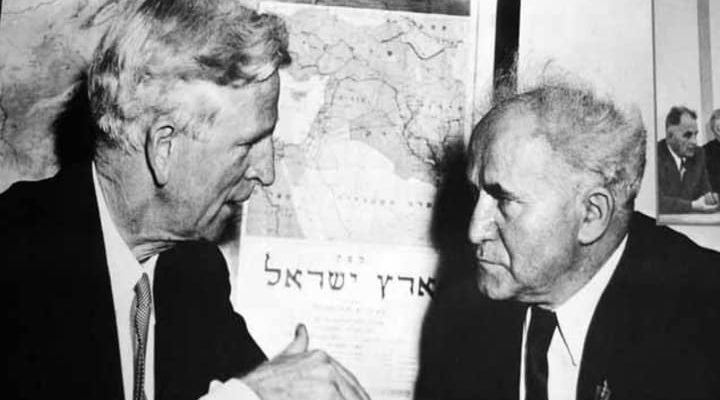News Release: January 10, 2019
WASHINGTON, D.C.- Twenty-nine Holocaust historians are urging the United States Holocaust Memorial Museum to correct its omission of an American diplomat who helped rescue 2,000 Jews.
The 29 historians this week wrote to U.S. Holocaust Museum director Sara Bloomfield to protest the omission of the late James G. McDonald from the museum’s new “Americans and the Holocaust” exhibit.
McDonald was an American scholar and diplomat who helped secure U.S. visas for at least 2,000 Jews fleeing the Nazis. He also bluntly criticized the Roosevelt administration for its abandonment of Europe’s Jews.
“James G. McDonald courageously spoke truth to power,” the 29 historians wrote this week. “The U.S. Holocaust Memorial Museum should recognize and honor his courage by adding him to the ‘Americans and the Holocaust’ exhibit as soon as possible.”
Ironically, the museum’s director, Sara Bloomfield, sent a letter to Dr. Barbara McDonald Stewart, the daughter of James McDonald, on March 24, 2014, promising that the Museum “will feature him in our upcoming exhibition on Americans and the Holocaust.” (http://wymaninstitute.org/wp-content/uploads/2019/01/Bloomfield-letter-to-Barbara.pdf ). But that promise was not kept; McDonald is not mentioned anywhere in the 5,000-square foot exhibit.
Dr. Rafael Medoff, director of the David S. Wyman Institute for Holocaust Studies, which organized the letter by the 29 historians, said: “It’s sad and disappointing that an exhibit about Americans and the Holocaust does not have one word about this righteous American who helped rescue thousands of Jews from the Holocaust. We hope the museum will yet fulfill the promise it made to the McDonald family to feature him in this exhibit.”
The full text of the letter by the 29 historians:
January 10, 2019
Ms. Sara J. Bloomfield, Executive Director
United States Holocaust Memorial Museum
100 Raoul Wallenberg Place SW
Washington, D.C. 20024
sbloomfield@ushmm.org
Dear Ms. Bloomfield,
As scholars who have researched and written about the Holocaust, we are surprised and disappointed that James G. McDonald, who worked tirelessly to rescue Jews from the Holocaust, is not mentioned anywhere in the new “Americans and the Holocaust” exhibit at the United States Holocaust Memorial Museum.
In a 5,000-square foot exhibit, surely room can be found for the man who served as League of Nations High Commissioner for Refugees Coming from Germany and chairman of the President’s Advisory Committee on Political Refugees. According to Prof. Richard Breitman, “McDonald actually helped saved many thousands of lives.” *
As you will recall, you wrote to Dr. Barbara Stewart McDonald, the eminent historian and daughter of James G. McDonald, on March 24, 2014: “Your father’s remarkable story is crucially important to the Museum, and that is why we have published his diaries, included him in our permanent exhibition and will feature him in our upcoming exhibition on Americans and the Holocaust.”
We would be very interested to know why you and your colleagues changed your position, from planning to “feature” McDonald in the exhibit, to omitting him entirely.
Seventy-five years ago this spring, McDonald undertook a remarkable series of lectures, articles, and letters in which he bluntly charged that the Roosevelt administration and its allies had exhibited “calamitous blindness” and “indifference” toward Jews fleeing Hitler; that they had “paid only lip service” and “acted timidly or failed to act at all…they have been guilty of face-saving maneuvers while millions of innocent men and women have been needlessly sacrificed.” **
James G. McDonald courageously spoke truth to power. The U.S. Holocaust Memorial Museum should recognize and honor his courage by adding him to the “Americans and the Holocaust” exhibit as soon as possible.
Cordially,
Prof. Irving Abella
York University
Prof. Paul R. Bartrop
Director, Center for Judaic, Holocaust and Genocide Studies
Florida Gulf Coast University
Prof. Judy Baumel-Schwartz
Bar Ilan University
Prof. Alan Berger
Florida Atlantic University
Prof. Aaron Berman
Hampshire College
Dr. Harold Brackman
Simon Wiesenthal Center
Prof. Zev Garber
Los Angeles Valley College (emer.)
Founding Editor, Studies in the Shoah
Prof. Haim Genizi
Bar-Ilan University (emer.)
Rabbi Prof. David Golinkin
President, The Schechter Institutes, Inc.
Dr. Elvira Groezinger
Berlin – SPME
Prof. Ron Hollander
Montclair State University (emer.)
Prof. Stephen L. Jacobs
University of Alabama
Prof. Vincent A. Lapomarda, S.J., S.T.L.
Coordinator of the Hiatt Holocaust Collection
College of the Holy Cross
Prof. Laurel Leff
Northeastern University
Dr. Rafael Medoff
The David S. Wyman Institute for Holocaust Studies
Prof. Rochelle L. Millen
Wittenberg University (emer.)
Prof. Paul B. Miller
McDaniel College
Prof. Stephen H. Norwood
University of Oklahoma
Prof. Zsuzsanna Ozsvath
Leah and Paul Lewis Chair of Holocaust Studies
University of Texas, Dallas
Prof. Monty N. Penkower
Machon Lander Graduate Center (emer.)
Prof. Eunice G. Pollack
Coeditor, Encyclopedia of American Jewish History
Prof. Allen Podet
Buffalo State – The State University of New York
Prof. Sara Reguer
Chair, Department of Judaic Studies
Brooklyn College
Prof. Peter I. Rose
Smith College (emer.)
Prof. Shlomo Slonim
James G. McDonald Professor of American History (emer.)
Hebrew University
Dr. Racelle Weiman
Temple University (ret.)
Prof. Sonja Wentling
Concordia College
Prof. John C. Zimmerman
University of Nevada Las Vegas
Prof. Bat-Ami Zucker
Bar Ilan University
(Institutions listed for identification purposes only.)
* interview with Prof. Breitman in “A Voice Among the Silent,” at 48:36.
** McDonald address to Bnai Brith, Buffalo, NY, May 22, 1944; address to United Palestine Appeal, Chicago, November 19, 1944; letter to Felix Frankfurter, November 30, 1944.

